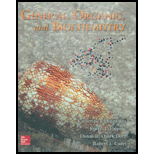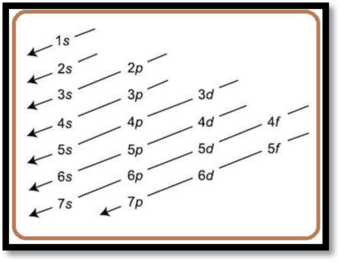
GENERAL,ORGANIC,+BIOCHEM.(LL) >CUSTOM<
10th Edition
ISBN: 9781264116546
Author: Denniston
Publisher: MCG CUSTOM
expand_more
expand_more
format_list_bulleted
Question
Chapter 2, Problem 2.87QP
(a)
Interpretation Introduction
Interpretation:
The electron configuration and orbital diagram of Boron atom has to be written.
Concept Introduction:
Electron configuration: The complete description of the atomic orbitals occupied by all the electrons in an atom is known as electron configuration.
Aufbau principle says that electron fills the lowest energy level before filling the higher ones.

Figure 1
(b)
Interpretation Introduction
Interpretation:
The electron configuration and orbital diagram of Sulfur atom has to be written.
Concept Introduction:
Refer part (a).
(c)
Interpretation Introduction
Interpretation:
The electron configuration and orbital diagram ofArgon atom have to be written.
Concept Introduction:
Refer part (a).
Expert Solution & Answer
Want to see the full answer?
Check out a sample textbook solution
Students have asked these similar questions
When propionic aldehyde in vapor form at 200 mmHg and 30°C is irradiated with radiation of wavelength 302 nm, the quantum yield with respect to the formation of CO is 0.54. If the intensity of the incident radiation is 1.5x10-3 W, find the rate of formation of CO.
Draw mechanism
Does Avogadro's number have units?
Chapter 2 Solutions
GENERAL,ORGANIC,+BIOCHEM.(LL) >CUSTOM<
Ch. 2.1 - Calculate the number of protons, neutrons, and...Ch. 2.1 - How many protons, neutrons, and electrons are...Ch. 2.1 - How many protons, neutrons, and electrons are...Ch. 2.1 - The element nitrogen has two naturally occurring...Ch. 2.1 - Prob. 2.3PPCh. 2.3 - Prob. 2.3QCh. 2.3 - Prob. 2.4QCh. 2.4 - Prob. 2.5QCh. 2.4 - Using the periodic table, write the symbol for...Ch. 2.4 - Refer to the periodic table, and find the...
Ch. 2.4 - Refer to the periodic table, and find the...Ch. 2.4 - Prob. 2.9QCh. 2.4 - For each of the following element symbols, give...Ch. 2.5 - Prob. 2.4PPCh. 2.5 - Prob. 2.5PPCh. 2.5 - Prob. 2.6PPCh. 2.6 - Prob. 2.7PPCh. 2.6 - Prob. 2.8PPCh. 2.6 - Determine the number of protons and electrons in...Ch. 2.6 - Prob. 2.12QCh. 2.6 - Provide the charge of the most probable ion...Ch. 2.6 - Prob. 2.13QCh. 2.6 - Which of the following pairs of atoms and ions are...Ch. 2.6 - Prob. 2.10PPCh. 2.6 - Prob. 2.15QCh. 2.6 - Prob. 2.16QCh. 2.7 - Prob. 2.17QCh. 2.7 - Prob. 2.18QCh. 2 - Prob. 2.19QPCh. 2 - Why is the number of electrons not part of the...Ch. 2 - Fill in the blanks:
Isotopes of an element differ...Ch. 2 - Identify which of the following isotopic symbols...Ch. 2 - Identify the major difference and the major...Ch. 2 - Label each of the following statements as true or...Ch. 2 - Label each of the following statements as true or...Ch. 2 - The nuclei of three different atoms are depicted...Ch. 2 - Calculate the number of protons, neutrons, and...Ch. 2 - Calculate the number of protons, neutrons, and...Ch. 2 - An atom has nine protons, ten neutrons, and nine...Ch. 2 - An atom has nineteen protons, twenty neutrons, and...Ch. 2 - How many protons are in the nucleus of the isotope...Ch. 2 - Prob. 2.32QPCh. 2 - Selenium-80 is a naturally occurring isotope used...Ch. 2 - Prob. 2.34QPCh. 2 - Write symbols for each isotope:
Each atom contains...Ch. 2 - Prob. 2.36QPCh. 2 - The element copper has two naturally occurring...Ch. 2 - The element lithium has two naturally occurring...Ch. 2 - Prob. 2.39QPCh. 2 - Prob. 2.40QPCh. 2 - Describe the experiment that provided the basis...Ch. 2 - Prob. 2.42QPCh. 2 - Prob. 2.43QPCh. 2 - Prob. 2.44QPCh. 2 - Prob. 2.45QPCh. 2 - Prob. 2.46QPCh. 2 - Prob. 2.47QPCh. 2 - Prob. 2.48QPCh. 2 - Prob. 2.49QPCh. 2 - Prob. 2.50QPCh. 2 - Prob. 2.51QPCh. 2 - Prob. 2.52QPCh. 2 - Describe electromagnetic radiation according to...Ch. 2 - Prob. 2.54QPCh. 2 - Is the following statement true or false?
Light of...Ch. 2 - Prob. 2.56QPCh. 2 - Prob. 2.57QPCh. 2 - Prob. 2.58QPCh. 2 - Describe the process that occurs when electrical...Ch. 2 - When electrical energy is applied to an element in...Ch. 2 - Prob. 2.61QPCh. 2 - Prob. 2.62QPCh. 2 - Prob. 2.63QPCh. 2 - Prob. 2.64QPCh. 2 - What was the major contribution of Bohr’s atomic...Ch. 2 - What was the major deficiency of Bohr’s atomic...Ch. 2 - Provide the atomic number, atomic mass, and name...Ch. 2 - Provide the atomic number, atomic mass, and name...Ch. 2 - Prob. 2.69QPCh. 2 - Prob. 2.70QPCh. 2 - Which group of the periodic table is known as the...Ch. 2 - Prob. 2.72QPCh. 2 - For each of the elements Na, Ni, Al, P, Cl, and...Ch. 2 - Prob. 2.74QPCh. 2 - Prob. 2.75QPCh. 2 - Prob. 2.76QPCh. 2 - Distinguish between a principal energy level and a...Ch. 2 - Distinguish between a sublevel and an orbital.
Ch. 2 - Sketch a diagram and describe our current model of...Ch. 2 - How is a 2s orbital different from a 1s orbital?
Ch. 2 - Prob. 2.81QPCh. 2 - For any given principal energy level, what is the...Ch. 2 - State the Pauli exclusion principle. Explain how...Ch. 2 - State Hund’s rule. Determine whether the following...Ch. 2 - Using the periodic table, write the electron...Ch. 2 - Using the periodic table, write the electron...Ch. 2 - Using the periodic table, write the electron...Ch. 2 - Using the periodic table, write the electron...Ch. 2 - Which of the following electron configurations are...Ch. 2 - Prob. 2.90QPCh. 2 - Determine whether the following orbital diagrams...Ch. 2 - Identify the element for each of the orbital...Ch. 2 - Use the periodic table and determine the shorthand...Ch. 2 - Prob. 2.94QPCh. 2 - Prob. 2.95QPCh. 2 - Prob. 2.96QPCh. 2 - State the octet rule.
Ch. 2 - Prob. 2.98QPCh. 2 - Prob. 2.99QPCh. 2 - Prob. 2.100QPCh. 2 - How many total electrons and valence electrons are...Ch. 2 - Prob. 2.102QPCh. 2 - Prob. 2.103QPCh. 2 - Prob. 2.104QPCh. 2 - Prob. 2.105QPCh. 2 - Predict the number of valence electrons in an atom...Ch. 2 - Prob. 2.107QPCh. 2 - Prob. 2.108QPCh. 2 - Prob. 2.109QPCh. 2 - Prob. 2.110QPCh. 2 - Prob. 2.111QPCh. 2 - Prob. 2.112QPCh. 2 - Prob. 2.113QPCh. 2 - Prob. 2.114QPCh. 2 - Prob. 2.115QPCh. 2 - Prob. 2.116QPCh. 2 - Prob. 2.117QPCh. 2 - Prob. 2.118QPCh. 2 - Prob. 2.119QPCh. 2 - Prob. 2.120QPCh. 2 - Prob. 2.121QPCh. 2 - Prob. 2.122QPCh. 2 - Prob. 2.123QPCh. 2 - Prob. 2.124QPCh. 2 - Explain why a positive ion is always smaller than...Ch. 2 - Prob. 2.126QPCh. 2 - Prob. 2.127QPCh. 2 - Prob. 2.128QPCh. 2 - For the isotope chlorine-37:
How many protons are...Ch. 2 - A natural sample of chromium, taken from the...Ch. 2 - For the element sulfur, provide the following...Ch. 2 - Prob. 5MCPCh. 2 - Prob. 7MCP
Knowledge Booster
Learn more about
Need a deep-dive on the concept behind this application? Look no further. Learn more about this topic, chemistry and related others by exploring similar questions and additional content below.Similar questions
- Explain why the total E in an Einstein depends on the frequency or wavelength of the light.arrow_forwardIf the dissociation energy of one mole of O2 is 5.17 eV, determine the wavelength that must be used to dissociate it with electromagnetic radiation. Indicate how many Einstein's of this radiation are needed to dissociate 1 liter of O2 at 25°C and 1 atm of pressure.Data: 1 eV = 96485 kJ mol-1; R = 0.082 atm L K-1; c = 2.998x108 m s-1; h = 6.626x10-34 J s; NA = 6.022x 1023 mol-1arrow_forwardIndicate the number of Einsteins that are equivalent to 550 kJ mol⁻¹ of absorbed energy (wavelength 475 nm).arrow_forward
- Indicate the number of einsteins that are equivalent to 550 kJ mol⁻¹ of absorbed energy?arrow_forwardA unit used in photochemistry is the einstein. If 400 kJ mol-1 of energy has been absorbed, how many einsteins is this equivalent to?arrow_forwardFor the condensation reaction between Alanine and histidine write the amididation reaction mechanism using arrows then write the three letter code for the product of the reaction and the one letter code for the product of the reaction.arrow_forward
- Name the following molecules using iupacarrow_forwardWrite the amididation reaction mechanism of a-aminophenol and acetic acid to produce acetaminophenarrow_forwardFor the condensation reaction between Alamine and histamine, please help me write the amididation reaction mechanism. Then write the three letter code for the product of the reaction, then write the one letter code for the product of the reaction. arrow_forward
arrow_back_ios
SEE MORE QUESTIONS
arrow_forward_ios
Recommended textbooks for you
 ChemistryChemistryISBN:9781305957404Author:Steven S. Zumdahl, Susan A. Zumdahl, Donald J. DeCostePublisher:Cengage Learning
ChemistryChemistryISBN:9781305957404Author:Steven S. Zumdahl, Susan A. Zumdahl, Donald J. DeCostePublisher:Cengage Learning ChemistryChemistryISBN:9781259911156Author:Raymond Chang Dr., Jason Overby ProfessorPublisher:McGraw-Hill Education
ChemistryChemistryISBN:9781259911156Author:Raymond Chang Dr., Jason Overby ProfessorPublisher:McGraw-Hill Education Principles of Instrumental AnalysisChemistryISBN:9781305577213Author:Douglas A. Skoog, F. James Holler, Stanley R. CrouchPublisher:Cengage Learning
Principles of Instrumental AnalysisChemistryISBN:9781305577213Author:Douglas A. Skoog, F. James Holler, Stanley R. CrouchPublisher:Cengage Learning Organic ChemistryChemistryISBN:9780078021558Author:Janice Gorzynski Smith Dr.Publisher:McGraw-Hill Education
Organic ChemistryChemistryISBN:9780078021558Author:Janice Gorzynski Smith Dr.Publisher:McGraw-Hill Education Chemistry: Principles and ReactionsChemistryISBN:9781305079373Author:William L. Masterton, Cecile N. HurleyPublisher:Cengage Learning
Chemistry: Principles and ReactionsChemistryISBN:9781305079373Author:William L. Masterton, Cecile N. HurleyPublisher:Cengage Learning Elementary Principles of Chemical Processes, Bind...ChemistryISBN:9781118431221Author:Richard M. Felder, Ronald W. Rousseau, Lisa G. BullardPublisher:WILEY
Elementary Principles of Chemical Processes, Bind...ChemistryISBN:9781118431221Author:Richard M. Felder, Ronald W. Rousseau, Lisa G. BullardPublisher:WILEY

Chemistry
Chemistry
ISBN:9781305957404
Author:Steven S. Zumdahl, Susan A. Zumdahl, Donald J. DeCoste
Publisher:Cengage Learning

Chemistry
Chemistry
ISBN:9781259911156
Author:Raymond Chang Dr., Jason Overby Professor
Publisher:McGraw-Hill Education

Principles of Instrumental Analysis
Chemistry
ISBN:9781305577213
Author:Douglas A. Skoog, F. James Holler, Stanley R. Crouch
Publisher:Cengage Learning

Organic Chemistry
Chemistry
ISBN:9780078021558
Author:Janice Gorzynski Smith Dr.
Publisher:McGraw-Hill Education

Chemistry: Principles and Reactions
Chemistry
ISBN:9781305079373
Author:William L. Masterton, Cecile N. Hurley
Publisher:Cengage Learning

Elementary Principles of Chemical Processes, Bind...
Chemistry
ISBN:9781118431221
Author:Richard M. Felder, Ronald W. Rousseau, Lisa G. Bullard
Publisher:WILEY
Quantum Numbers, Atomic Orbitals, and Electron Configurations; Author: Professor Dave Explains;https://www.youtube.com/watch?v=Aoi4j8es4gQ;License: Standard YouTube License, CC-BY
QUANTUM MECHANICAL MODEL/Atomic Structure-21E; Author: H to O Chemistry;https://www.youtube.com/watch?v=mYHNUy5hPQE;License: Standard YouTube License, CC-BY